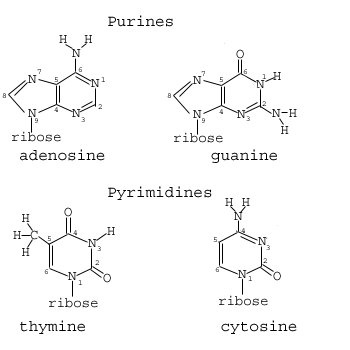In Unit 1, we investigated the structure of the nucleic acids DNA and RNA. DNA and RNA are the major molecules of heredity and understanding their structure is critical to understanding the mechanisms of gene replication and protein synthesis. The structural elements of each of these molecules play key roles in their ability to transmit genetic information from one generation to the next.
As you will remember, there are five kinds of nucleotides. Each of these bases are often abbreviated by a single letter: A (adenine), C (cytosine), G (guanine), T (thymine), U (uracil). The bases come in two categories: thymine, cytosine, and uracil are pyrimidines, while adenine and guanine are purines (Figure 6.01). The pyrimidine structure contains a single ring structure while the purine structure contains a double ring structure.

Figure 6.01: DNA Bases
In eukaryotes, this genetic information is stored in multiple linear chromosomes that consist of double-stranded DNA. In prokaryotes, chromosomes are typically circular and form a loop. Both kinds of organisms may also contain plasmids, which are small, double-stranded, circular DNA molecules that are not part of the chromosomes. Plasmids are typically associated with prokaryotes but are also found in some eukaryotes like yeast. When in the double-stranded form, one strand is oriented in the 5' to 3' direction while the complementary strand runs in the 3' to 5' direction. The two strands bond through their nitrogen bases. Note that adenine only bonds with thymine or uracil, and cytosine only bonds with guanine.
The rest of this unit will focus on the processes responsible for replicating the nucleic acid DNA, transcribing DNA into RNA, and translating an RNA sequence into a functional protein. We will also discuss how genes are regulated and expressed as well as the effect of mutations on an organism. Knowledge of these topics is fundamental to understanding what inside our bodies allowed us to grow into humans, why our growth is different from that of other organisms, and how this information is passed on to future generations.













